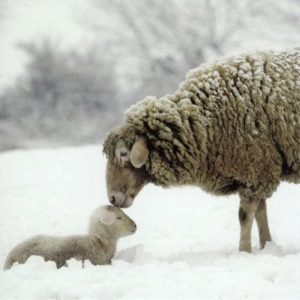Lambing In Bad Weather
26 March 2018The extended period of snowfall and the plummeting temperatures couldn’t have come at a worse time for heavily in lamb sheep and their stockmen. At this stage in pregnancy the ewe is under huge pressure, being heavily pregnant, growing lamb(s), forming mammary tissue, etc. As the abundance of snow melts, very wet fields and flooding will be the next issue for ewes.
Nutrition is key in late pregnancy, even more so when the ground is covered in snow. The ewe’s energy requirements rise by an astonishing 60% between 7 weeks and 1 week pre lambing (70kg ewe with twins). Plus a little extra for cold weather (0.11MJ for each 10kg). As well as nutrition being key, ensuring stress is kept to a minimum is vital.
Ewes must be supplemented sufficiently by offering ad lib forage, e.g. hay/silage, this should be high quality to ensure high intake levels. In addition lifted brassicas such as swedes, fodder beet, etc. can be offered to ewes to further supplement them. High quality concentrate should be offered to the ewes but ensure there is adequate trough space (50cm/ewe) to reduce stress and competition or use a snacker. If feeding high rates of concentrate feeding remember to gradually build up the ration and then split over two feeds per day, with no one feed being more than 0.5kg/head. High energy blocks/buckets are a great way to offer additional energy to ewes. Offer these to hill lambs this winter, in order to train them to eat blocks/buckets for the future. A guideline of 1 block/bucket per 30 ewes is recommended.
Housing ewes in late pregnancy can be stressful. Ensure housing is the only management change within the day, e.g. don’t mix groups, vaccinate, change feeding, etc. to minimise stress and the risk of twin lamb disease.
For those lambing indoors, there will no doubt be a backlog of pens. Ensure there are plenty of release pens and remember the importance of hygiene. A simple dusting of disinfectant powder and fresh straw between occupants of a pen greatly improves hygiene conditions for the newborn lamb.
It is inevitably going to be a late spring, with grass growth being slow. Ensure you plan for this by ensuring you have adequate forage supplies for an extra month by means of conserved forage or lifted brassicas. If the ewes do not have access to good quality forage they will not supply adequate milk for there lambs (peak milk yield is 3-4 weeks post lambing), resulting in poor weaning weights and a possible increase in lamb losses. Manging ewe condition will be vitally important this year following the hard winter that they have endured.
Kirsten Williams, kirsten.williams@sac.co.uk
Sign up to the FAS newsletter
Receive updates on news, events and publications from Scotland’s Farm Advisory Service

